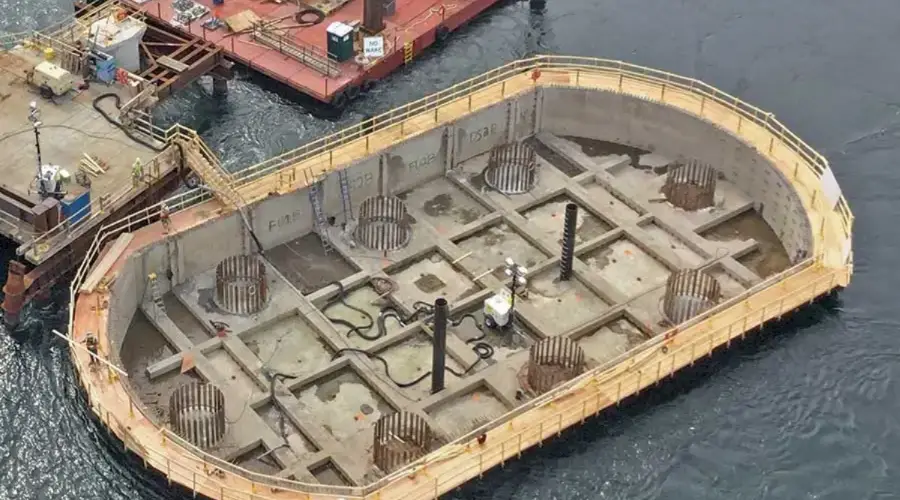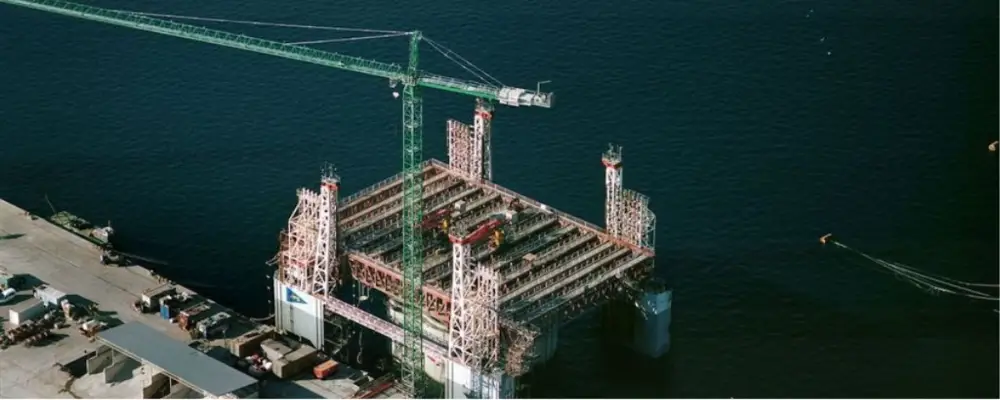The need for land and space is growing steadily each day. The rise of global trade among all countries increases the demand for the transportation of goods from one place to another through maritime channels. Similar to land, maritime traffic is also increasing. To resolve this issue, construction professionals use floating caissons. Floating caissons can be used in the construction of seaports, docks, and harbours, which are essential places for loading and unloading goods from the sea. Let us explain in detail the ways floating caissons work, their applications, advantages and disadvantages, the materials used for making caissons, and the construction process.
What is a Floating Caisson?
The floating caissons are prefabricated concrete constructions with cylindrical voids or chambers that resemble boxes. They are made with specialised equipment called “Floating Docks.” These caissons’ proportions are customised to fit the unique requirements of every project while staying within predetermined bounds. Floating caissons facilitate international trade by expanding the ports and also supporting the construction of ship vessels and protecting against wave action and the transfer of goods.
These caissons can be used to do different kinds of marine work. They are mentioned below:
- Ports
- Breakwaters
- Wharves
- Berthing Facilities and Docks
- Dry Docks and Slipways
- Fishing Ports and Marinas
How do Floating Caissons Work?
During building and installation, floating caissons use their buoyancy to function. With steel and reinforced concrete reinforcements, these massive, hollow concrete buildings are constructed off-site or in dry docks and are intended to float because of their hollow nature. Once built, tugboats or other propelling devices are used to float the caisson to the intended destination.
The caisson is ballasted with water or heavy materials like sand or gravel after it arrives at the installation site to sink it to the necessary depth. It settles on the seafloor as it sinks, giving future construction projects like piers and bridges a solid foundation. To guarantee stability against waves, tides, and currents, the caisson is secured to the seabed using piles, cables, or other techniques after it has been positioned. After the caisson is anchored, further building tasks, such as adding utilities or superstructures, can be carried out on top of it.
The caisson can then be joined to other caissons or structures to provide a wider platform for the construction project, and additional ballast adjustments can be made to guarantee the caisson stays level and stable. All things considered, floating caissons use buoyancy to facilitate transportation and accurate positioning, offering a sturdy base for maritime construction projects.
Applications of Floating Caissons
A variety of maritime works and harbour structures are built using floating caissons, which include harbours, wharves, dry docks and slipways, berthing facilities and docks, fishing ports and marinas, breakwaters. These structures rely on caissons that create sturdy, secure foundations to endure the harsh marine environment, such as waves, tides, and currents. Because they provide dependable support for large loads and maritime operations, caissons are crucial to the security and operation of important maritime infrastructures.
Advantages of Floating Caissons

- Because of their tremendous load-bearing capability, floating caissons are perfect for sustaining large, weighty structures like piers and bridges.
- They provide flexibility in areas where conventional foundation techniques would not be practical due to their adaptability to deep-water construction.
- For large-scale marine construction projects, floating caissons may be more cost-effective than traditional deep foundation techniques, despite the initial installation being more expensive.
- Project durations are accelerated by the prefabrication and floating capabilities, which shorten on-site building times.
- Sensitive ecosystems benefit from them since they disturb the marine environment less than pile-driving methods do.
- Because floating caissons are simple to move or reposition, they can be adjusted to accommodate shifting project needs or site circumstances.
- They are dependable in difficult situations because they are less impacted by changing soil conditions.
Disadvantages of Floating Caissons
- Floating caissons can be expensive to construct and install, particularly in deep water or challenging environments.
- The installation process is complex and requires specialised equipment, increasing both time and cost.
- They are less suitable for shallow water or low-depth areas where other foundation methods may be more effective.
- Floating caissons are vulnerable to environmental forces such as strong currents, waves, and storms, which can impact their stability during installation or use.
- Significant noise and vibration can be created during the installation process of floating caissons, which causes disturbance to marine life and nearby communities.
- Due to their location in water, regular ongoing checks are required to confirm their structural integrity.
- During installation and relocation, they may cause environmental impacts, such as disruptions to marine ecosystems.
- Floating caissons require precise positioning and anchoring, making them sensitive to changing field conditions and weather.
Materials Used in Floating Caissons
The equipment and resources used for construction activities around floating caissons are as follows:
- Concrete
- Sand
- Reinforcements
- The floating dock that holds concrete delivery pipes and a crane
- Auxiliary floating platforms
- Batch plant
- Concrete pumps
- Gantry crane
- Loaders
- Air compressors
- Pneumatic pumps
- Workmen on a shift basis
Construction Process of Floating Caissons
Step 1: Concrete Preparation
Preparing the concrete is the first step in the caisson prefabrication process. Two distinct equipment configurations work together to manage various steps in the process. The following are the steps: A batch of concrete is created in a mixer and then moved into a hopper that is attached to a concrete pump. A delivery pipe that is situated above the work platform then carries the concrete.
Step 2: Slab Construction
Starting with the base slab, each caisson is built in an ascending order. After being prepped on a secondary floating platform, the slab’s reinforcing structure is moved to the floating dock. The slab is formed as one unified piece using a movable mould.
Step 3: Building the Upper Sections
With the use of a movable mould, work on the higher portions of the caisson begins once the slab is finished, moving upward in one-meter intervals. In each step, the concrete is poured and compacted, the mould is adjusted, and reinforcing is installed. Until the caisson reaches its maximum height, this procedure is repeated.
Step 4: Releasing the Caisson
When the caisson is finished, it is released from the floating dock by disassembling a specific support and locking bar system. With the help of tugboats and ropes anchored on the coast, the caisson becomes buoyant and is guided to its destination.
Step 5: Final Placement and Filling
Granular materials fill the cylindrical spaces inside the caisson when it reaches its final place. Support vessels that are outfitted with the material and a specialised crane for its transfer are used to complete this task.
Step 6: Preparation for the Next Caisson
On top of the caisson, equipment like trucks, loaders, tractors, and bulldozers finish the filling operation. Meanwhile, at the floating dock, work on building the next caisson begins.
Conclusion
To sum up, floating caissons give stability and support in deep-water settings, making them a dependable option for marine building projects. They are perfect for construction like ports, breakwaters, and offshore platforms because of their ability to float, enabling convenient transportation and accurate placement. Floating caissons are regarded for their great load-bearing capacity, versatility, and longevity, making them crucial for current harbour and infrastructure development in maritime settings, despite installation obstacles and the requirement for specialised equipment.
FAQs
Depending on the materials used, the surrounding environment, maintenance procedures, and the kind of marine activities, a floating caisson’s lifespan normally varies from 30 to 50 years.
Whereas a traditional caisson is pre-sunk or cast on-site, a floating caisson is buoyant, transported, and sunk into place, perfect for deep sea.
Structural integrity inspections, controlled ballasting, environmental monitoring, tugboat support for accurate placement, worker protection gear, and secure anchoring to stop movement are all examples of safety precautions during installation. Safe operations are guaranteed by constant communication, emergency response plans, and adherence to safety procedures.

